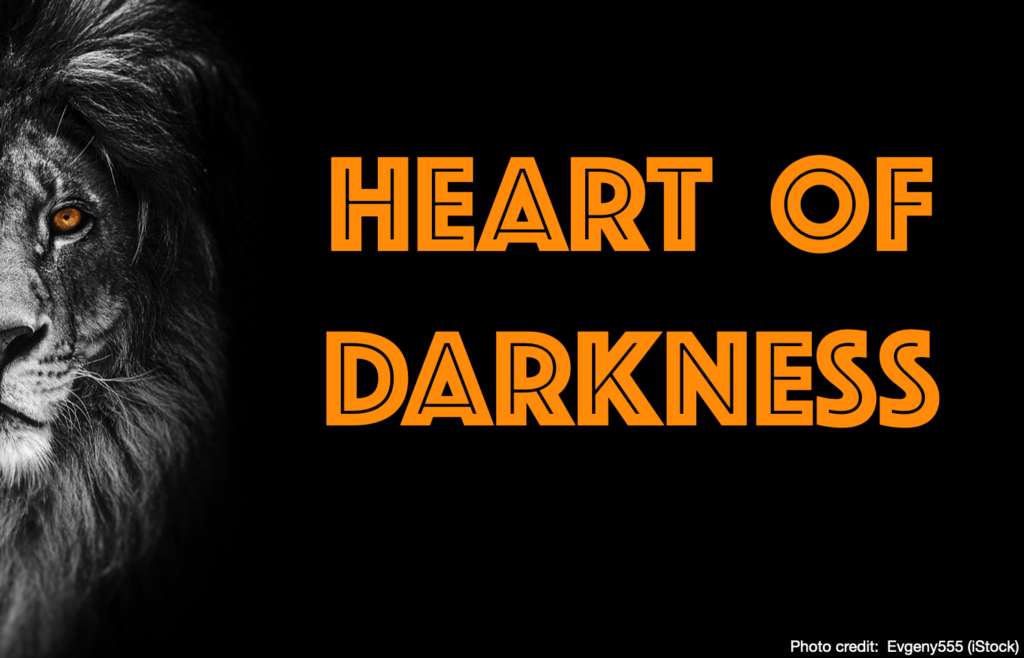Charles Marlow is the protagonist in Conrad’s book, but Marlow might as well be Joseph Conrad, himself, as they both shared similar experiences (including passage on the Congo River.) Marlow is hired to run a rundown sternwheeler of a steamship up and down the river carrying passengers and merchandise, particularly ivory. The Congo River begins in the highlands of Lake Tanganyika and Lake Mweru and then (at least on the maps) carves an ugly, inverted, half-moon scar before it exits at the Atlantic city of Moanda (population 50,000.)
Marlow is in search on his first voyage of a man called Kurtz. Kurtz, like many Europeans who have overstayed their welcome in the Congo, is dying and suffering dementia to boot. In fact, seems that everyone in the Congo is dying. Conrad notes that the Africans “were dying slowly—it was very clear. They were not enemies, they were not criminals, they were nothing earthly now but black shadows of disease and starvation, lying confusedly in the greenish gloom.” He blames this on being “lost in uncongenial surroundings” and being “fed on unfamiliar food.” As a result, “they sickened , became inefficient, and then were allowed to crawl away and rest (p.20.)”
The Whites who mistreated the blacks (Conrad uses what today is a perjorative term to describe the indigenous people in the book) were likewise ill. The “manager” noted how most of the agents of the “company” were stricken ill and remarked “Men who come out here should have no entrails” (p.26) suggesting that the disease that so ravished them was dysentery or someone similar bug. Conrad rarely calls people by name. There is the doctor, the lawyer, the fat man and so on.
Marlow cannot understand the natives, nor does he seem to try. He takes their bondage as a matter of fact without being particularly sympathetic. In fact, there are issues not only of colonialism but racism as well in the book. I don’t want to go afield here, but I want to mention that Europeans of that time (and likely even today) “defined themselves as a technologically and intellectually superior race, and they used this haughty attitude to justify the colonial rule of those ‘less civilized’ (Rizzo, p. 1.)” People from Africa, Asian, India, South America and so forth were thought to be savage, and Kipling referred to them as the “white man’s burden.” The problem was and as Marlow discovers and Conrad points out, Europeans were equally savage and brutal in their dealings with these other races. So then, who is the civilized and who is the savage? It’s like the last scene in Orwell’s Animal Farm where the animals wonder who are the pigs and who are the people?
This classification (civilized vs savage) is present in the use of adjectives in the book. “Heart of Darkness also introduces the closely related theme of light verses dark, or white versus black. Light and dark have traditionally represented good and evil, and civilization has generally been viewed as good while savagery has been seen as evil. Conrad plays with this theme extensively, sometimes using the imagery in traditional ways and sometimes creating surprising and meaningful reversals (Nofal p. 78.)” Rousseau at least had his noble savage, but there are no redeeming qualities that Marlow is aware of as far as the natives go.
“Darkness is night, the unknown, the impenetrable the primitive, the evil. Yet when he reaches Africa the colours of skin invert the accepted association of the contrast. “White” is above all ivory, the beautiful luxury of civilized man which is the root of all evil in the darkness (Nofal p. 78.)”. So then, what was really meant a century ago by the term “Darkest Africa?”
The longer the whites in the company stayed in the Congo, the darker their hearts became as they became increasingly savage themselves, as evidenced by Kurtz’s private army. And with the darkness came the descent into madness. Another interesting observation is that the further one went upriver, the more savage people became (“prehistoric” is the term Conrad uses.). This is sort of like what Doug McClure discovered in the movie “The Land That Time Forgot.” Nor did the Africans, themselves have a monopoly on brutality. Europeans (and Americans) could be equally savage when the occasion presented itself (e.g. Wounded Knee.)
Today, our society and culture is shrouded in darkness. Mothers name their children after vampires. Television series become darker each season. Graphic violence is perpetrated on small children. Unfortunately, many of us have become immune to this and our entertainment becomes progressively evil and perverse. No race has an monopoly on savagery, unfortunately. Because we all have hearts of darkness unless we’ve opened them to the Gospel.
For more about colonialism in Africa, click here.
Citations
Nofal, Kahlil Hassan “Darkness in Conrad’s Heart of Darkness,” The Buckingham Journal of Language and Linguistics 2013 Volume 6 pp 77-93.
Rizzo, Michelle. “Marlowe’s Questionable Racism: The Struggle between Human Sentiment and Nurtured Principles.” The Review: A Journal of Undergraduate Student Research 6 (2003): 1-7.
